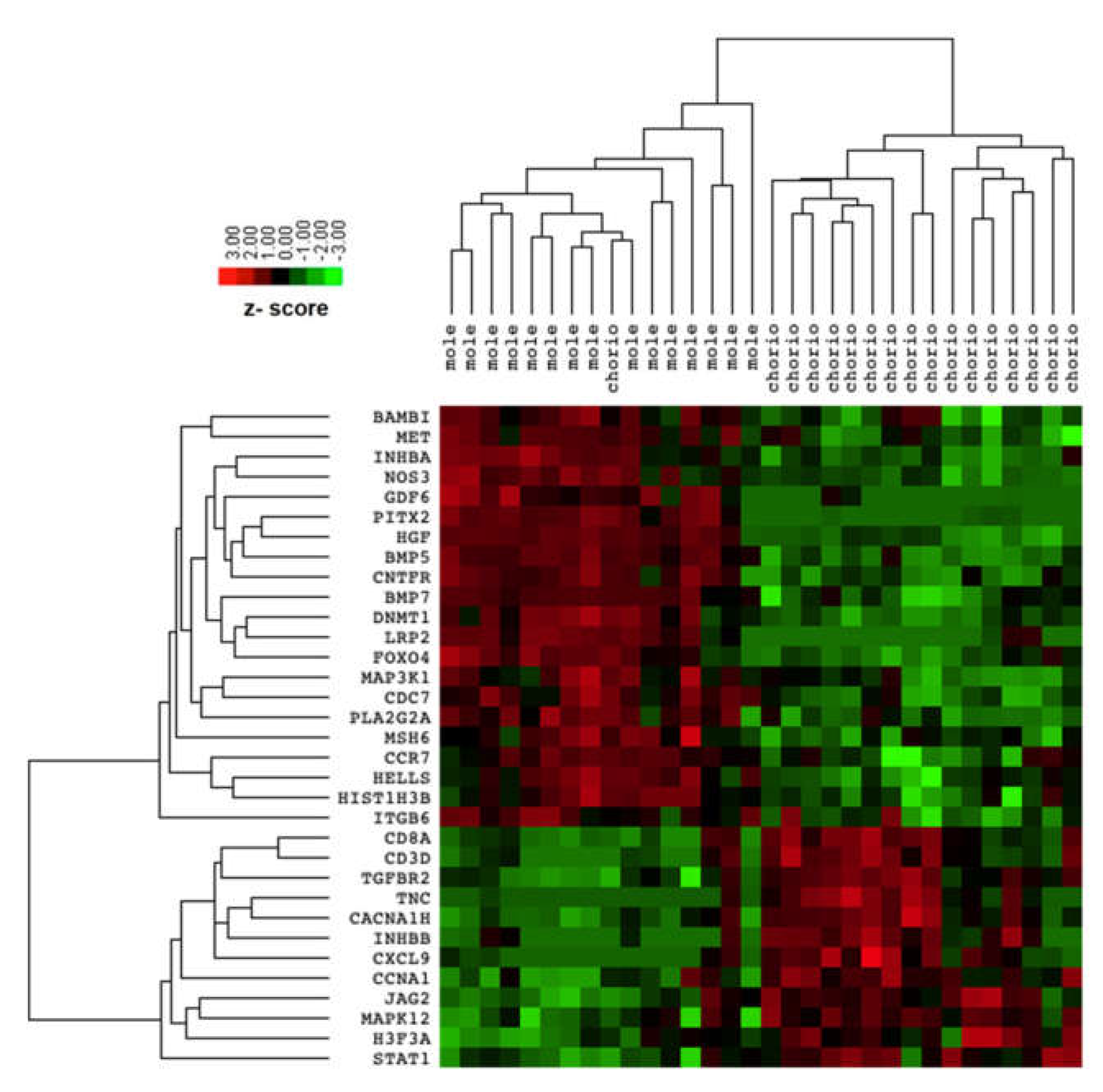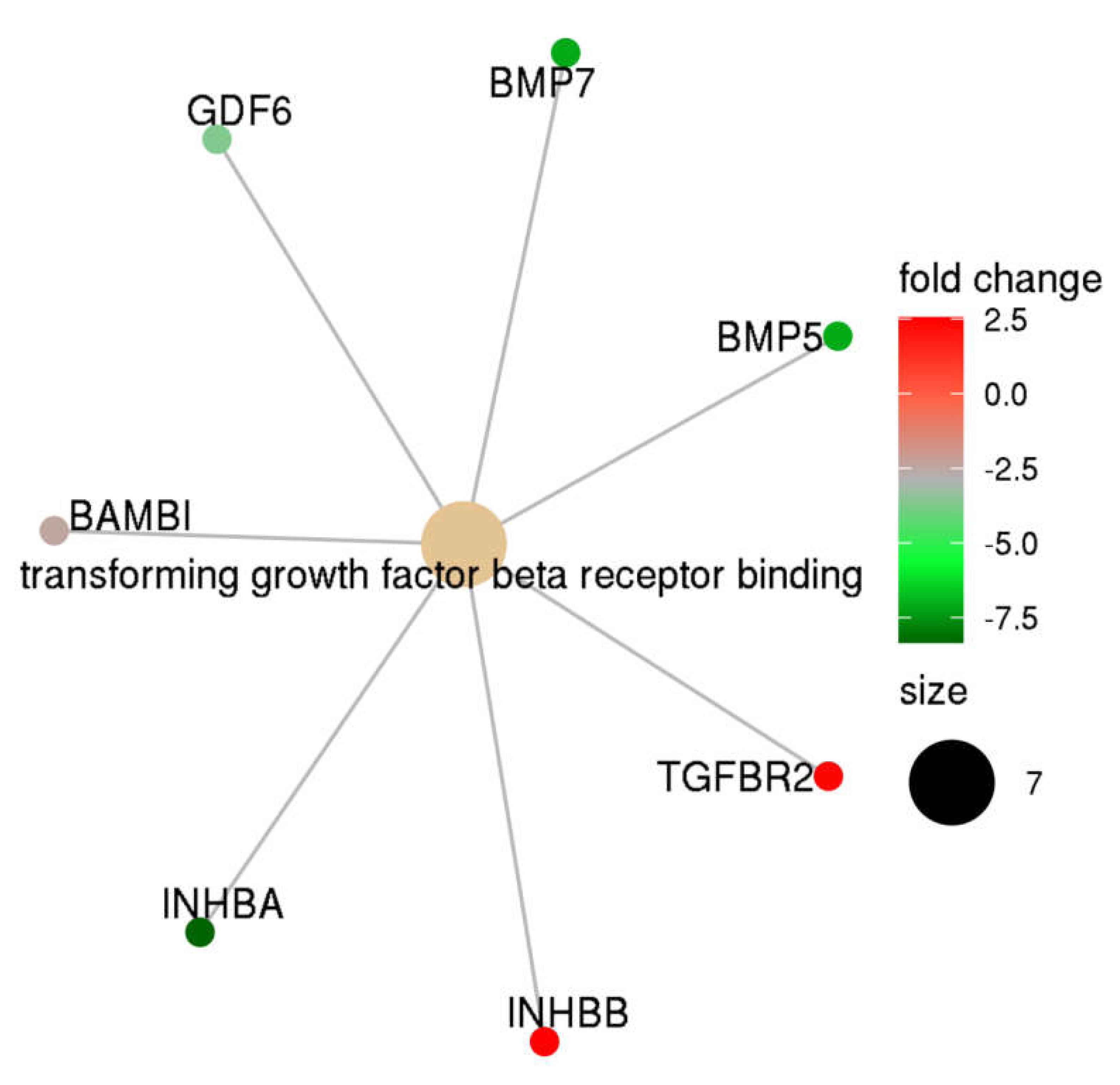Transcriptomic Characterization of Postmolar Gestational Choriocarcinoma
Abstract
:1. Introduction
2. Material and Methods
2.1. Patients and Samples
2.2. RNA Extraction
2.3. Gene Expression
2.4. Generation of Normalized Data
2.5. Principal Component Analysis
2.6. Differential Gene Expression Analysis
2.7. Biological Pathway Enrichment Analysis
2.8. Immunohistochemistry
3. Results
3.1. Comparison of Complete Moles versus Postmolar Choriocarcinoma
3.1.1. Clinical Characteristics
3.1.2. Differential Gene Expression between Complete Mole and Postmolar Choriocarcinoma
3.1.3. Pathway Analysis
3.1.4. TGF-β Upstream Analysis
3.2. Comparison of Postmolar Choriocarcinoma versus Post-Term Delivery Choriocarcinoma
Differential Gene Expression between Postmolar Choriocarcinoma and Post-Term Delivery Choriocarcinoma
4. Discussion
Supplementary Materials
Author Contributions
Funding
Institutional Review Board Statement
Informed Consent Statement
Acknowledgments
Conflicts of Interest
References
- Costanzo, V.; Bardelli, A.; Siena, S.; Abrignani, S. Exploring the Links between Cancer and Placenta Development. Open Biol. 2018, 8, 180081. [Google Scholar] [CrossRef] [Green Version]
- Coorens, T.H.H.; Oliver, T.R.W.; Sanghvi, R.; Sovio, U.; Cook, E.; Vento-Tormo, R.; Haniffa, M.; Young, M.D.; Rahbari, R.; Sebire, N.; et al. Inherent Mosaicism and Extensive Mutation of Human Placentas. Nature 2021, 592, 80–85. [Google Scholar] [CrossRef] [PubMed]
- Nguyen, N.M.P.; Ge, Z.-J.; Reddy, R.; Fahiminiya, S.; Sauthier, P.; Bagga, R.; Sahin, F.I.; Mahadevan, S.; Osmond, M.; Breguet, M.; et al. Causative Mutations and Mechanism of Androgenetic Hydatidiform Moles. Am. J. Hum. Genet. 2018, 103, 740–751. [Google Scholar] [CrossRef] [PubMed] [Green Version]
- Fisher, R.A.; Maher, G.J. Genetics of Gestational Trophoblastic Disease. Best Pract. Res. Clin. Obstet. 2021, 74, 29–41. [Google Scholar] [CrossRef] [PubMed]
- Bolze, P.-A.; Lopez, J.; Allias, F.; Hajri, T.; Patrier, S.; Devouassoux-Shisheboran, M.; Massardier, J.; You, B.; Golfier, F.; Mallet, F. Transcriptomic and Immunohistochemical Approaches Identify HLA-G as a Predictive Biomarker of Gestational Choriocarcinoma Resistance to Monochemotherapy. Gynecol. Oncol. 2020, 158, 785–793. [Google Scholar] [CrossRef] [PubMed]
- Savage, P.; Winter, M.; Parker, V.; Harding, V.; Sita-Lumsden, A.; Fisher, R.A.; Harvey, R.; Unsworth, N.; Sarwar, N.; Short, D.; et al. Demographics, Natural History and Treatment Outcomes of Non-Molar Gestational Choriocarcinoma; A UK Population Study. BJOG Int. J. Obstet. Gynaecol. 2020, 127, 1102–1107. [Google Scholar] [CrossRef]
- Bolze, P.-A.; Riedl, C.; Massardier, J.; Lotz, J.-P.; You, B.; Schott, A.-M.; Hajri, T.; Golfier, F. Mortality Rate of Gestational Trophoblastic Neoplasia with a FIGO Score of ≥13. Am. J. Obstet. Gynecol. 2016, 214, 390.e1. [Google Scholar] [CrossRef]
- Xuan, Y.H.; Choi, Y.L.; Shin, Y.K.; Ahn, G.H.; Kim, K.H.; Kim, W.J.; Lee, H.C.; Kim, S.H. Expression of TGF-Beta Signaling Proteins in Normal Placenta and Gestational Trophoblastic Disease. Histol. Histopathol. 2007, 22, 227–234. [Google Scholar] [PubMed]
- Graham, C.H.; Connelly, I.; MacDougall, J.R.; Kerbel, R.S.; Stetler-Stevenson, W.G.; Lala, P.K. Resistance of Malignant Trophoblast Cells to Both the Anti-Proliferative and Anti-Invasive Effects of Transforming Growth Factor-β. Exp. Cell Res. 1994, 214, 93–99. [Google Scholar] [CrossRef] [PubMed]
- Wilson, R.L.; Jones, H.N. Targeting the Dysfunctional Placenta to Improve Pregnancy Outcomes Based on Lessons Learned in Cancer. Clin. Ther. 2021, 43, 246–264. [Google Scholar] [CrossRef] [PubMed]
- Ding, N.; Zhang, B.; Ying, W.; Song, J.; Feng, L.; Zhang, K.; Li, H.; Xu, J.; Xiao, T.; Cheng, S. A Time-Resolved Proteotranscriptomics Atlas of the Human Placenta Reveals Pan-Cancer Immunomodulators. Signal Transduct. Target Ther. 2020, 5, 110. [Google Scholar] [CrossRef]
- Bolze, P.A.; Massardier, J.; Buénerd, A.; Béjui, F.T.; Perrin, C.; Rouvet, I.; Sanlaville, D.; Mazé, M.C.; Dufay, N.; Gaucherand, P.; et al. Elaboration of a national biobank for the study of gestational trophoblastic diseases. J. Gynécol. Obs. Biol. Reprod. 2016, 45, 559–562. [Google Scholar] [CrossRef] [PubMed]
- Bolze, P.-A.; Attia, J.; Massardier, J.; Seckl, M.J.; Massuger, L.; van Trommel, N.; Niemann, I.; Hajri, T.; Schott, A.-M.; Golfier, F.; et al. Formalised Consensus of the European Organisation for Treatment of Trophoblastic Diseases on Management of Gestational Trophoblastic Diseases. Eur. J. Cancer 2015, 51, 1725–1731. [Google Scholar] [CrossRef] [PubMed]
- Committee, F.O. FIGO Staging for Gestational Trophoblastic Neoplasia 2000. Int. J. Gynecol. Amp. Obstet. 2002, 77, 285–287. [Google Scholar] [CrossRef]
- Ayers, M.; Lunceford, J.; Nebozhyn, M.; Murphy, E.; Loboda, A.; Kaufman, D.R.; Albright, A.; Cheng, J.D.; Kang, S.P.; Shankaran, V.; et al. IFN-γ–Related MRNA Profile Predicts Clinical Response to PD-1 Blockade. J. Clin. Investig. 2017, 127, 2930–2940. [Google Scholar] [CrossRef] [PubMed]
- Reynaud, D.; Nahed, R.A.; Lemaitre, N.; Bolze, P.-A.; Traboulsi, W.; Sergent, F.; Battail, C.; Filhol, O.; Sapin, V.; Boufettal, H.; et al. NLRP7 Promotes Choriocarcinoma Growth and Progression through the Establishment of an Immunosuppressive Microenvironment. Cancers 2021, 13, 2999. [Google Scholar] [CrossRef]
- Powles, T.; Young, A.; Sanitt, A.; Sammit, A.; Stebbing, J.; Short, D.; Bower, M.; Savage, P.M.; Seckl, M.J.; Schmid, P. The Significance of the Time Interval between Antecedent Pregnancy and Diagnosis of High-Risk Gestational Trophoblastic Tumours. Br. J. Cancer 2006, 95, 1145–1147. [Google Scholar] [CrossRef] [Green Version]
- Ma, Y.; Xiang, Y.; Wan, X.R.; Chen, Y.; Feng, F.Z.; Lei, C.Z.; Yang, X.Y. The Prognostic Analysis of 123 Postpartum Choriocarcinoma Cases. Int. J. Gynecol. Cancer 2007, 18, 1097–1101. [Google Scholar] [CrossRef] [PubMed]
- Riyami, N.A.; Gowri, V.; Kakaria, A.K.; Lakhtakia, R. A Case of Postpartum Choriocarcinoma: Delay in Diagnosis and Lessons Learnt. J. Obstet. Gynecol. India 2014, 64, 29–31. [Google Scholar] [CrossRef] [Green Version]
- Zhang, L.; Ye, Y.; Long, X.; Xiao, P.; Ren, X.; Yu, J. BMP Signaling and Its Paradoxical Effects in Tumorigenesis and Dissemination. Oncotarget 2015, 5, 78206–78218. [Google Scholar] [CrossRef] [PubMed] [Green Version]
- Chen, E.; Yang, F.; He, H.; Li, Q.; Zhang, W.; Xing, J.; Zhu, Z.; Jiang, J.; Wang, H.; Zhao, X.; et al. Alteration of Tumor Suppressor BMP5 in Sporadic Colorectal Cancer: A Genomic and Transcriptomic Profiling Based Study. Mol. Cancer 2018, 17, 176. [Google Scholar] [CrossRef] [PubMed] [Green Version]
- Pellatt, A.J.; Mullany, L.E.; Herrick, J.S.; Sakoda, L.C.; Wolff, R.K.; Samowitz, W.S.; Slattery, M.L. The TGFβ-Signaling Pathway and Colorectal Cancer: Associations between Dysregulated Genes and MiRNAs. J. Transl. Med. 2018, 16, 191. [Google Scholar] [CrossRef] [PubMed]
- Kita, A.; Kasamatsu, A.; Nakashima, D.; Endo-Sakamoto, Y.; Ishida, S.; Shimizu, T.; Kimura, Y.; Miyamoto, I.; Yoshimura, S.; Shiiba, M.; et al. Activin B Regulates Adhesion, Invasiveness, and Migratory Activities in Oral Cancer: A Potential Biomarker for Metastasis. J. Cancer 2017, 8, 2033–2041. [Google Scholar] [CrossRef] [Green Version]
- Assarnia, S.; Khales, S.A.; Forghanifard, M.M. Correlation between SALL4 Stemness Marker and Bone Morphogenetic Protein Signaling Genes in Esophageal Squamous Cell Carcinoma. J. Biochem. Mol. Toxicol. 2019, 33, e22262. [Google Scholar] [CrossRef]
- Zhang, X.; Zhang, P.; Shao, M.; Zang, X.; Zhang, J.; Mao, F.; Qian, H.; Xu, W. SALL4 Activates TGF-β/SMAD Signaling Pathway to Induce EMT and Promote Gastric Cancer Metastasis. Cancer Manag. Res. 2018, 10, 4459–4470. [Google Scholar] [CrossRef] [Green Version]
- Stichelbout, M.; Devisme, L.; Franquet-Ansart, H.; Massardier, J.; Vinatier, D.; Renaud, F.; Kerdraon, O. SALL4 Expression in Gestational Trophoblastic Tumors: A Useful Tool to Distinguish Choriocarcinoma from Placental Site Trophoblastic Tumor and Epithelioid Trophoblastic Tumor. Hum. Pathol. 2016, 54, 121–126. [Google Scholar] [CrossRef]
- Seoane, J.; Gomis, R.R. TGF-β Family Signaling in Tumor Suppression and Cancer Progression. Cold Spring Harb. Perspect. Biol. 2017, 9, a022277. [Google Scholar] [CrossRef] [PubMed] [Green Version]
- Lin, L.H.; Maestá, I.; Laurent, J.D.S.; Hasselblatt, K.T.; Horowitz, N.S.; Goldstein, D.P.; Quade, B.J.; Sun, S.Y.; Braga, A.; Fisher, R.A.; et al. Distinct MicroRNA Profiles for Complete Hydatidiform Moles at Risk of Malignant Progression. Am. J. Obstet. Gynecol. 2021, 224, 372.e1–372.e30. [Google Scholar] [CrossRef] [PubMed]



| Complete Mole | Postmolar Choriocarcinoma | |
|---|---|---|
| n = 14 | n = 17 | |
| Age (mean, range), y | 37 (25–55) | 35 (26–55) |
| Serum hCG before D&C | ||
| FIGO score (median, range) | - | 3 (0–8) |
| hCG at treatment initiation (median, range); IU/L | - | 19,098 (739–201,938) |
| Larger tumor size >5 cm (n) | - | 3 |
| FIGO stage (n) | - | |
| I | - | 14 |
| II | - | 1 |
| III | - | 2 |
| First-line treatment (n) | - | |
| Monochemotherapy (methotrexate) | - | 9 |
| Polychemotherapy (EMA-CO) | - | 5 |
| Surgery (hysterectomy) | - | 3 |
| Gene Name | Relative Expression Fold Change | FDR Adjusted p-Value |
|---|---|---|
| BMP5 | −7.08 | 0 |
| BMP7 | −7.12 | 0 |
| CDC7 | −1.97 | 0 |
| CNTFR | −6.08 | 0 |
| DNMT1 | −2.53 | 0 |
| GDF6 | −3.69 | 0 |
| HGF | −26.08 | 0 |
| INHBA | −8.34 | 0 |
| LRP2 | −10.54 | 0 |
| NOS3 | −4.75 | 0 |
| PITX2 | −9.83 | 0 |
| BAMBI | −2.46 | 0.01 |
| CACNA1H | 5.53 | 0.01 |
| CCNA1 | 2.04 | 0.01 |
| CD8A | 4.19 | 0.01 |
| FOXO4 | −2.54 | 0.01 |
| HELLS | −1.92 | 0.01 |
| MET | −3.77 | 0.01 |
| TGFBR2 | 2.39 | 0.01 |
| TNC | 4.04 | 0.01 |
| H3F3A | 1.36 | 0.02 |
| JAG2 | 2.35 | 0.02 |
| MAPK12 | 2.43 | 0.02 |
| PLA2G2A | −8.05 | 0.02 |
| HIST1H3B | −2.54 | 0.03 |
| INHBB | 2.55 | 0.03 |
| MAP3K1 | −1.29 | 0.03 |
| MSH6 | −1.37 | 0.03 |
| STAT1 | 1.98 | 0.03 |
| CCR7 | −3.38 | 0.04 |
| CD3D | 3.12 | 0.04 |
| CXCL9 | 5.86 | 0.04 |
| ITGB6 | −2.3 | 0.04 |
| Postmolar Choriocarcinoma | Post-Term Delivery Choriocarcinoma | |
|---|---|---|
| n = 17 | n = 20 | |
| Age (mean, range), y | 35 (26–55) | 31 (23–45) |
| FIGO score (median, range) | 3 (0–8) | 9.5 (3–17) |
| Interval since antecedent pregnancy termination >12 months (n) | 6 | 6 |
| hCG at treatment initiation (median, range); IU/L | 19,098 (739–201,938) | 39,069 (735–479,771) |
| Larger tumor size >5cm (n) | 3 | 10 |
| Liver or brain metastasis (n) | 0 | |
| FIGO stage (n) | ||
| I | 14 | 9 |
| II | 1 | 0 |
| III | 2 | 8 |
| IV | 0 | 3 |
| First-line treatment (n) | ||
| Monochemotherapy (methotrexate) | 9 | 7 |
| Polychemotherapy (EMA-CO) | 5 | 13 |
| Surgery (hysterectomy) | 3 | 0 |
| Death (n) | 0 | 10 |
| Gene Name | Relative Expression Fold Change | FDR Adjusted p-Value |
|---|---|---|
| MSH2 | 1.58 | 0.08 |
| LTBP1 | −1.97 | 0.09 |
| RAC1 | −1.29 | 0.09 |
Publisher’s Note: MDPI stays neutral with regard to jurisdictional claims in published maps and institutional affiliations. |
© 2021 by the authors. Licensee MDPI, Basel, Switzerland. This article is an open access article distributed under the terms and conditions of the Creative Commons Attribution (CC BY) license (https://creativecommons.org/licenses/by/4.0/).
Share and Cite
Collet, C.; Lopez, J.; Battail, C.; Allias, F.; Devouassoux-Shisheboran, M.; Patrier, S.; Lemaitre, N.; Hajri, T.; Massardier, J.; You, B.; et al. Transcriptomic Characterization of Postmolar Gestational Choriocarcinoma. Biomedicines 2021, 9, 1474. https://doi.org/10.3390/biomedicines9101474
Collet C, Lopez J, Battail C, Allias F, Devouassoux-Shisheboran M, Patrier S, Lemaitre N, Hajri T, Massardier J, You B, et al. Transcriptomic Characterization of Postmolar Gestational Choriocarcinoma. Biomedicines. 2021; 9(10):1474. https://doi.org/10.3390/biomedicines9101474
Chicago/Turabian StyleCollet, Constance, Jonathan Lopez, Christophe Battail, Fabienne Allias, Mojgan Devouassoux-Shisheboran, Sophie Patrier, Nicolas Lemaitre, Touria Hajri, Jérôme Massardier, Benoit You, and et al. 2021. "Transcriptomic Characterization of Postmolar Gestational Choriocarcinoma" Biomedicines 9, no. 10: 1474. https://doi.org/10.3390/biomedicines9101474
APA StyleCollet, C., Lopez, J., Battail, C., Allias, F., Devouassoux-Shisheboran, M., Patrier, S., Lemaitre, N., Hajri, T., Massardier, J., You, B., Mallet, F., Golfier, F., Alfaidy, N., & Bolze, P.-A. (2021). Transcriptomic Characterization of Postmolar Gestational Choriocarcinoma. Biomedicines, 9(10), 1474. https://doi.org/10.3390/biomedicines9101474








